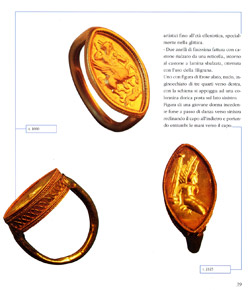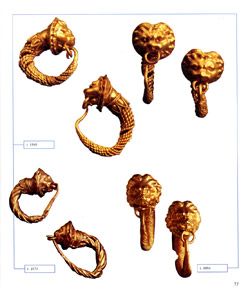
L. Bernaḅ Brea con M. Cavalier - Bellezza ed eleganza femminile nella Lipari greca ed ellenistica
Roma, 2005, pp 129, ed. ATON
The jewellery found in tombs of the necropolis of Contrada Diana, at Lipari, confirm the importance of the art of goldsmith’s work which contributed to female beauty during this period.
“In leafing through the pages of this volume, we pass through the principal classes, both in terms of form and function, of goldsmith’s work of the Hellenistic period, from the mid-4th century BC to the mid-1st century BC.
With the help of representations of women, both in paintings on red-figure vases and in statuettes of terracotta, finger rings, earrings, and necklaces no longer remain “museum pieces”, tidily ordered in glass cases, but re-acquire their original position in the complex of female embellishment in this remote period.
Sets of cosmetic utensils, from mirrors to balsamaria, permit us, in turn, to reconstruct in our imagination the procedure of dressing and personal adornment until it had reached its completion, as testified by the female images mentioned above.
We thus have before our eyes real women in Antiquity in all their integrity: not segments of them, whose mutual connection only the experts claim to be able to recompose.
These are women who dressed up and adorned themselves to participate in every possible solemnity, displaying precious dresses and exquisite jewellery, and exploiting the skilful art of cosmetics and hairstyles, for the ceremonies that punctuated the principal phases of their life. And all these ceremonies, from weddings to religious festivities, also assumed a social significance: in so far as the whole community participated in them, and each citizen, whether man or woman, strove to prove equal to them, to the best of their respective possibilities. As for the splendour and elegance of the individual, they concurred to represent the overall prosperity and power of the community of which they formed part. And nonetheless even this pronounced community spirit did not suppress a desire to outshine others, by flaunting in public more precious dresses, more exquisite and lavish jewellery, and more sophisticated coiffeurs than others.”
(P.G. GUZZO
Archaeological Superintendent of Pompeii)

